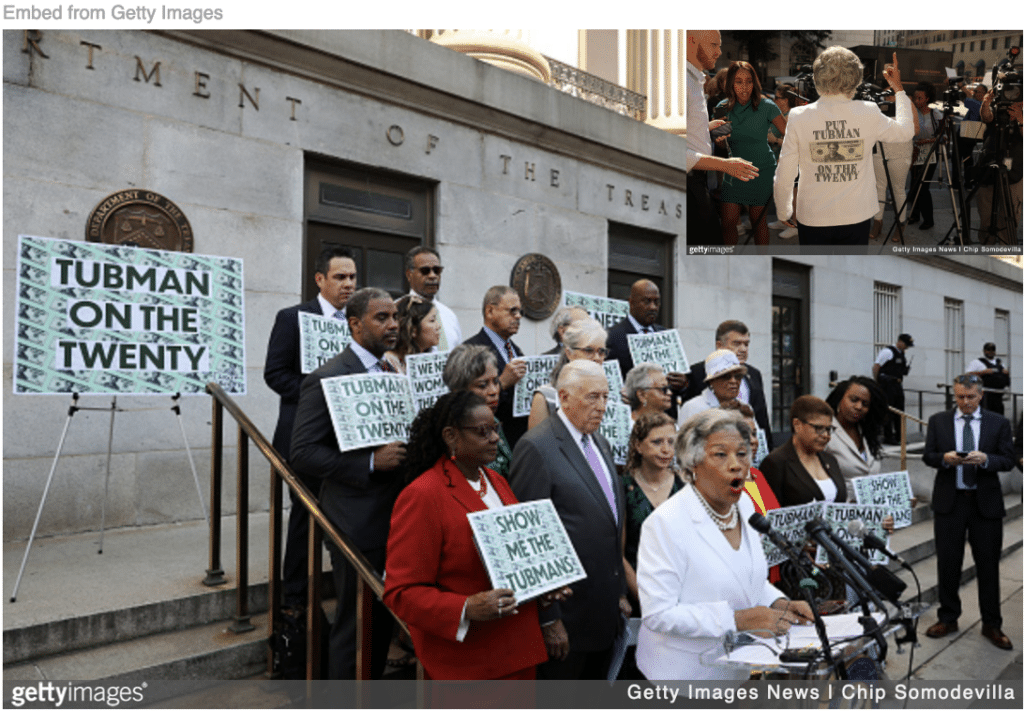
Woman on dollar bill
The US government is teasing plans to put a woman on a dollar bill. Except that paper currency is falling into desuetude. That’s why the media hype surrounding this belated and misguided honor seems contrived.
This celebration is like hailing the appointment of a Native American as Postmaster General of the United States Postal Service; that is, now that e-mails and instant messaging are all the rage.
Harriet Tubman?
With U.S. Treasury officials committing to putting a woman on a redesigned $10 bill, a front-runner for that numismatic honor appears to be Maryland’s own Harriet Tubman.
The woman who was born into slavery on an Eastern Shore plantation and became the most renowned of the Underground Railroad leaders has already won an online ‘election’ for the female face that voters wanted to see on a bill.
(The Baltimore Sun, June 18, 2015)
That this honor is so belated is insulting enough. But those hailing it should beware that, when or even if it happens, the chosen woman will join, not replace, Alexander Hamilton.
The sexism in that is so odious it cannot stand. Not least because influential political pundits are already deriding it like this:
This is basically the perfect embodiment of the women’s rights movement: women ask for what they’ve earned, a bunch of men get together and talk about it; then they give the women half and ask [them] to share it.
(Last Week Tonight with John Oliver, HBO, January 21, 2015)

A woman should replace Jackson instead of Hamilton
In any event, it’s unfair for the Treasury to honor Tubman (or any other woman) by dishonoring Hamilton. And it hardly matters if she joins or replaces him.
Here are just three of the many reasons why:
- Hamilton never enslaved people.
- He was the first Treasury Secretary of the United States.
- Most relevant, he did more than any other American to create the US central banking system – complete with founding the Bank of New York in 1784, which provided a cash-strapped US government its first loan just five years later.
After the Revolutionary War ended, the nation had substantial debt [and] there was no common currency, as many states printed their own money.
These were two of the chief financial problems facing the nation’s founders around the time the Constitution was written. Alexander Hamilton thought having the federal government take over the states’ war debts would be a good way to fix these problems while establishing federal power preeminent over that of the states, another of his goals.
(“History of Central Banking in the United States,” Federal Reserve Bank of Minneapolis.org)
Instead, as the “Women on 20s” campaign proposes, it’s fairer to honor Tubman by dishonoring Andrew Jackson, whose face now graces the $20 bill.
Here are just three of the many reasons why:
- Jackson enslaved people. He also nearly wiped out Native Americans in the Southeastern United States, highlighted by forcing thousands of Cherokees on the “Trail of Tears” – which makes the Bataan Death March look like a Sunday stroll – as the White man’s solution to their “Indian problem.”
- He pioneered the patronage system that seeded corruption in US politics.
- Most relevant, he tried more than any other American to destroy the US central banking system – complete with attempts to discard paper currency in favor of coins as the only legal tender.
Jackson had been financially damaged by speculation and a tightening of bank credit early in his business career. He retained a distrust of financial institutions throughout his life. … Jackson’s opposition to the Bank became almost an obsession.
(“The War Against the Bank,” U.S. History.org)
Clearly, between these two Founding Framers, Jackson is more deserving of this dishonor. Not to mention the sexist slight inherent in putting a woman on Hamilton’s $10 bill; after all, it has only half the circulation (or everyday use) of Jackson’s $20 bill.
Furthermore, if the Treasury were to replace Jackson, his advocates could find solace in knowing he would remain the face of the one-dollar coin. However, if it were to replace Hamilton, his advocates would see his face relegated to the dustbin of history, where US currency is concerned.
Why is the Treasury blackballing Hamilton?
Frankly, the Treasury’s move to dishonor Hamilton defies logic and offends any sense of fairness. But I suspect this stems, ironically enough, from the abiding scourge of America’s “original” sin.
No less a person than President Obama explained the historical context this weekend as follows:
The legacy of slavery, Jim Crow, discrimination in almost every institution of our lives … that’s still part of our DNA. …
Racism, we are not cured of it; and it’s not just a matter of it not being polite to say nigger in public. That’s not the measure of whether racism still exists or not.
(NBC News, June 22, 2015)
That is why it’s no coincidence that (White) Treasury officials targeted Hamilton. After all, his is the only face on any dollar bill that has (or is thought to have) “Negro blood.”
Was Hamilton White or Black?
Hamilton was born out of wedlock to a French Huguenot of “mixed race” named Rachel Fawcett Lavine on the island of Nevis in the British West Indies. He moved to America at age 16. But nothing “consigned” him to a life of négritude, much to his chagrin, quite like this:
[The] incontestable truth that many, if not most, illegitimate children in the West Indies bore mixed blood. At the time of Rachel’s birth, the four thousand slaves on Nevis outnumbered whites by a ratio of four to one, making inequitable carnal relations between black slaves and white masters a dreadful commonplace.
(Chernow, Ron. ‘Alexander Hamilton.’ Penguin Publishing Group. Kindle Edition. p. 9)
Speculation about Hamilton’s race has been fodder for intrigue and slander throughout history. But this is not the forum, nor indeed the commentary, to argue the matter.
Still, one Mr. Adams presented colorful testimony about Hamilton’s race during a congressional hearing. It might add some authority to my race-based explanation to reference it.
For, as cited in the record at Interstate-Commerce Law, 1902, p. 40, Mr. Adams testified that:
- he possessed data showing Hamilton’s mother to be of “mixed blood”;
- Hamilton himself is a Negro, even though he looks as “light” as any White man; and
- if Hamilton were still alive, both of them would be subjected to Jim Crow laws … if people found out they were Negroes.
Indeed, accounts abound about Hamilton’s biological brother James looking far more like a Negro, so much so that he was refused a seat on a Broadway coach.
Apropos of Broadway, it’s an uncanny coincidence that the historical truth of Hamilton’s race is playing out these days in the hit musical Hamilton. That it’s being performed in hip-hop style is telling enough. But it features an actor of mixed race playing Hamilton.
The point is that, by dishonoring Hamilton, the Treasury is unwittingly proving Obama’s lament, namely that racism is still part of America’s DNA.